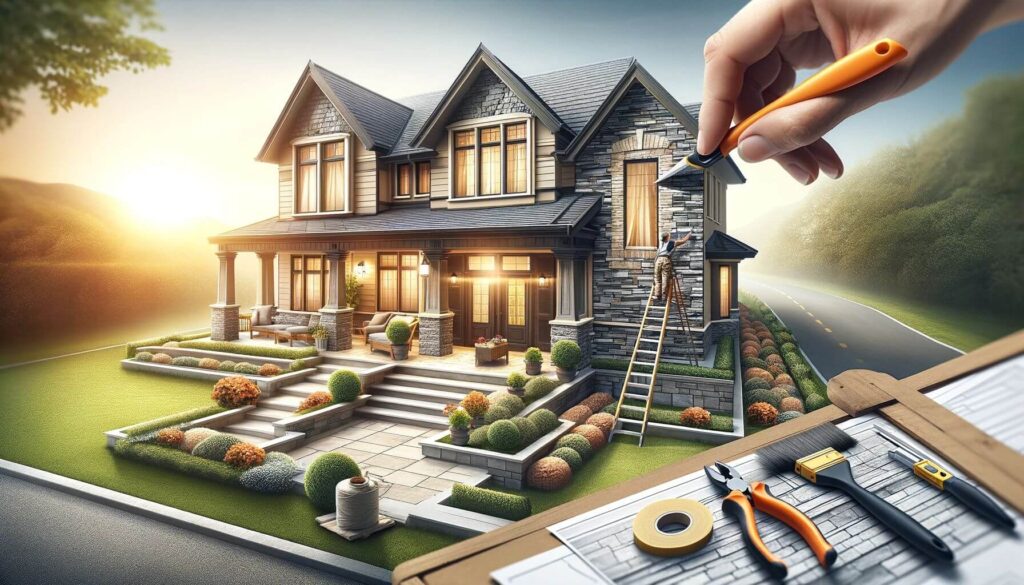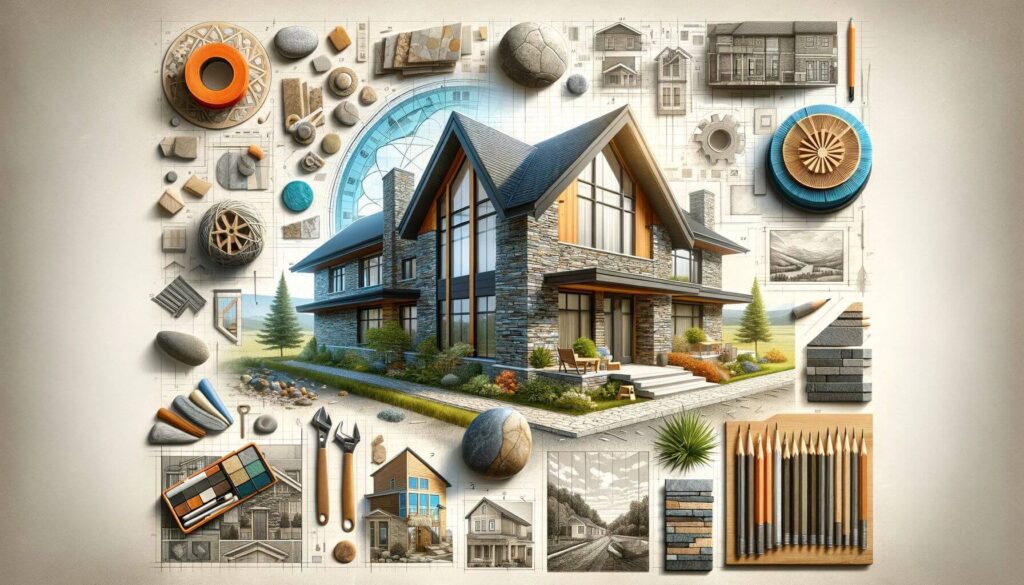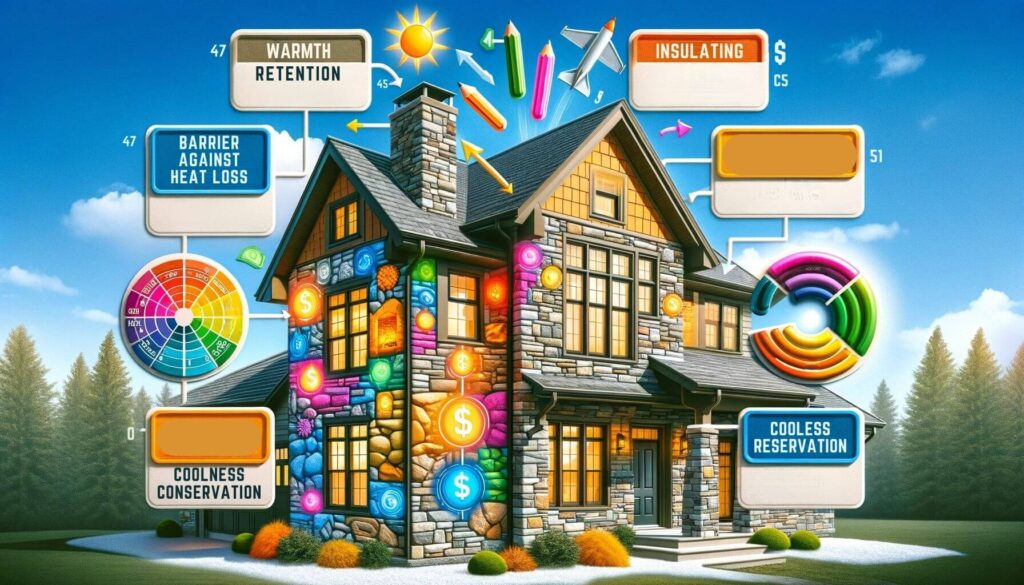
Stone veneer, a marvel in the world of modern home exteriors, is essentially a decorative facing material designed to replicate the look of natural stone. Its primary use involves adorning exterior walls, creating an appearance akin to traditional stone masonry.
Unlike full-sized stones, stone veneer is relatively lightweight, thanks to its thin slices. This feature makes it not only versatile for various architectural styles but also easier to install and more affordable than traditional stone.
The adaptability of stone veneer extends beyond just styles; it is also used to enhance other exterior elements such as columns, fireplaces, and water features, offering homeowners an array of design possibilities.
Evolution of Stone Veneer
The journey of stone veneer in architecture dates back centuries, originating from the use of natural stone in building construction. However, the modern incarnation of architectural stone overlay – thin, lightweight, and versatile – began gaining prominence in the 20th century.
This shift was driven by advancements in cutting technology, allowing for thinner slices of stone that retained the beauty and texture of thicker pieces. Over the years, stone veneer evolved further with the introduction of manufactured alternatives, which replicated the look of natural stone at a lower cost and with increased design flexibility.
Today, stone veneer stands as a testament to the blend of traditional aesthetics with modern technological advances, offering a sustainable and creative solution for enhancing home exteriors.

Diversity in Design of Stone Veneer
Stone veneer comes in two primary types, each offering unique characteristics and benefits.
Natural stone veneer is made from real stone that’s been quarried and cut into thin slices. This type boasts the authentic texture and color variations of natural stone, making each piece unique. Its durability and classic look make it a preferred choice for homeowners seeking an ageless and natural aesthetic.
Manufactured stone veneer, on the other hand, is a man-made product designed to mimic the look of natural stone. It’s typically made from a mixture of cement, natural aggregates, and pigments.
This type offers more uniformity in size and color, and it’s generally lighter and easier to install than natural stone veneer. It also tends to be more cost-effective, making it a popular choice for budget-conscious homeowners who don’t want to compromise on style.
Home Exteriors Appeal Enhanced
The aesthetic appeal of stone veneer lies in its ability to transform the exterior of a home dramatically. Whether you choose natural or manufactured stone veneer, it can add a sense of depth, texture, and sophistication to your home’s façade. With a wide range of colors, patterns, and styles available, stone veneer offers immense versatility in design.

It can be tailored to complement various architectural styles, from contemporary to traditional, fitting seamlessly with your home’s existing design elements. Beyond walls, stone veneer can be used to accentuate features like porches, columns, and outdoor living spaces, making it a versatile choice for those looking to enhance their home’s curb appeal and overall aesthetic.
Installation Process: Precision and Expertise
The installation of stone veneer is a task that combines artistry with precision. Initially, the surface is prepped, ensuring it is clean, dry, and structurally sound. A moisture barrier is then applied, followed by a metal lath to provide a sturdy base for the mortar.
The process of applying stone facade panel involves spreading a layer of mortar, setting the stones in place, and then grouting the spaces between them.
Each step demands attention to detail to ensure a secure fit and alignment that complements the home’s aesthetic. Professional installation is crucial as it guarantees the longevity and appearance of the stone veneer. Experts in masonry understand the nuances of different stone types and installation techniques, ensuring a finish that is not only beautiful but also enduring.
Durability and Maintenance: Long-Lasting Beauty with Ease

Stone veneer is prized for its durability and resistance to weather elements. Whether natural or manufactured, it withstands exposure to sun, wind, rain, and temperature fluctuations remarkably well. This resilience makes it a long-term addition to any home without the need for frequent repairs or replacements.
Maintenance of stone veneer is relatively low-key. Regular cleaning, usually with mild soap and water, is sufficient to keep its appearance fresh and vibrant. It’s also advisable to inspect the veneer periodically for any signs of damage or wear.
Such minimal maintenance requirements, coupled with its durable nature, make stone covering a practical and appealing choice for homeowners looking for a balance of aesthetics and functionality.
Energy Efficiency: Insulation Benefits of Stone Veneer
Stone veneer enhances a home’s energy efficiency in several ways. Its primary contribution is in insulation. When installed, stone veneer adds an extra layer to exterior walls.
This layer acts as a barrier against heat loss in winter and heat gain in summer, aiding in maintaining consistent indoor temperatures. Such insulation properties mean reduced reliance on heating and cooling systems, leading to lower energy bills.
Additionally, stone veneer’s thermal mass helps in regulating temperature fluctuations, making it an eco-friendly choice for homeowners concerned about energy consumption and seeking sustainable living solutions.
Customization Options: Tailoring Your Home’s Aesthetic
The customization potential of stone veneer is vast. Homeowners have a wide array of choices in color, texture, and pattern, allowing them to tailor their homes to their specific aesthetic preferences. Colors range from earthy browns and grays to more vibrant hues, fitting various design schemes.
Textures vary too, from smooth and polished to rugged and natural, offering an opportunity to create contrast or harmony with other architectural elements. Patterns in stone veneer installation can be customized as well, whether you prefer a traditional stacked look or a more intricate mosaic style.
This flexibility in design ensures that each installation of stone veneer is unique, reflecting the homeowner’s personal style and enhancing the overall character of the home. With stone veneer, the possibilities for customization are nearly limitless, allowing for a truly personalized approach to home design.

Comparative Advantages: Stone Veneer vs. Full-Sized Stone vs Other Exterior Options
When evaluating exterior options, stone veneer offers distinct advantages. In terms of cost, stone veneer is generally more affordable than traditional stone, making it a cost-effective choice for homeowners. The installation time for stone veneer is shorter compared to full-sized stone, due to its lightweight and manageable size.
This means less labor time and, consequently, lower installation costs. In terms of long-term value, stone veneer enhances a home’s curb appeal and can increase its resale value. Unlike other exterior options that might fade or degrade over time, stone veneer maintains its appearance and structural integrity, ensuring lasting benefits.
The Transformative Power of Stone Veneer
Consider a mid-century home that underwent a facade renovation with stone veneer. The addition revitalized the home’s appearance, making it one of the most attractive on the block, and significantly increased its market value.
Another example is a modern home that integrated stone veneer for its energy-efficient properties. The homeowners reported lower heating and cooling costs, alongside an increase in their property’s appraisal value. These success stories highlight not just the aesthetic enhancement but also the practical benefits of choosing stone veneer for home exteriors.




Thanks for helping me understand how stone veneers can boost the value of a property while improving its appearance. I have a friend who wants to use his backyard as something that he could brag to the neighborhood. I should talk to him about finding a landscaping store that can provide the materials he needs for the project.